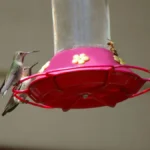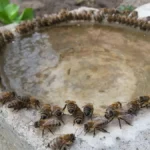In this article, we look at making sugar water for bees. There are times when bees need a bit of help from us – an energy boost – or even when we have to pay them back for taking their honey. Let us have a look at how to do this.
If we look at the Federal Reserve, there are times when it needs to introduce a bit of liquidity into the economy. As beekeepers, we help to manage the economies of our hives, and much like the Federal Reserve, we can introduce a bit of liquidity into our beehives – with sugar water. This gives them sugar, which is the energy currency of the hive. Using this sugar liquidity, the bees can perform various tasks. Let us look at what these are.
When Do We Feed Dry Sugar To Bees?
There are times when you can feed bees dry sugar (read more about that here and here). These are typically in winter in colder weather, and dry sugar helps to provide bees with energy, as well as to remove humidity. Most of the other times we feed bees we feed sugar solutions, as the bees consume these faster and more efficiently. I have also tried feeding bees dry sugar in summer and they normally just cart it out of the hive and dump it, which is a bit depressing and expensive.
When Do We feed Bees Liquid Sugar?
If we need to help boost the bees or help them increase their stores, we feed liquid sugar. This can either be fed via feeders inside the hive, or we can put sugar stations near an apiary and the bees will fetch this sugar and take it to the hive.
If bees have abundant sugar in spring they will use this sugar to increase the size of the hive population and to build wax combs. If we feed at the end of the season, we can help the bees to increase the weight of stores they have to get through winter. For the different times of the year, we use different concentrations of sugar, hence it is important to understand these ratios when making sugar water for bees.
Making Sugar Water For Bees
Sugar Mixture To Stimulate Growth and Hive Energy: 1 To 1 Mix
When we want our bees to grow and stimulate wax making, brood rearing, and population growth, we use a 1 to 1 sugar mix. This is 1 to 1 by volume. You can use whatever measuring device you have to achieve this. So it can be a gallon bucket of sugar to a gallon bucket of water.
I find the new types of white sugar (don’t use brown it will kill your bees) have special processes they use to make the sugar dissolve very fast. Ten to twenty years ago, dissolving sugar was a pain. Now you just put the sugar in the mixing vessel and pour a bit of warm water in.
Personally, I normally use a 50-gallon drum. I have a paddle mixer on my drill and I set that going in the warm water, and pour the sugar in through the mixer when it is running. It is a good idea to tie a rope around the drill and anchor it to something. I have dropped my drill in the sugar water twice now and it is a big job to strip a drill and wash all the sugar out of it.
Why The 1 To 1 Ratio
When sugar is in the 1 to 1 ratio it is relatively dilute. Nectar in flowers is more dilute at 1 to 10 concentrations on average, but if we mix sugar at too dilute a ratio it ferments very fast. A 1 to 1 ratio will be stable for about a week or so, which is enough time for the bees to process it.
Because it has high water content, the bees tend to ingest it, and then while it is ingested, some of the sucrose overloads certain metabolic pathways in the bee causing it to produce wax. Other bees are filled with energy, and the hive can then warm more scouts up and send them out looking for pollen. Hence the bees shift their focus to pollen gathering (because they have abundant sugar energy) and this is used to produce more bees.
Abundant sugar means the bees produce abundant heat and can warm the hive up to produce more brood, more scouts, wax, and just be more efficient. This is just like the Fed introducing quantitative easing – increasing money/honey supply increases economic development. Money is energy, and for the bees, sugar is their dollar.
Mixing Sugar Water For Encouraging Stores: 2 To 1 Mix
When we want to encourage the bees to store sugar in the hive, we use a 2 to 1 mix. Two parts sugar one part water by volume. Hence that would be for example 2 gallons of sugar and 1 gallon of water.
Why The 2 To 1 mix
This solution is more concentrated and the bees will tend to quickly process this and store it in the combs. The resulting stores are not honey – we never feed bees sugar to produce honey – that is cheating. However, if we remove honey and then feed the bees 2 to 1 sugar water so that we can get the hive up to the weight needed to survive winter, that is acceptable. The bees will eat all of the stored sugar syrup in the winter, and use the remainder in spring to build up the hive.
How Long Does Sugar Water Last?
Sugar water is an excellent growth medium for certain yeast. Many of these sugar-loving yeasts are actually found in beehives, and bees are covered in them. Each time a bee goes to drink sugar water, she is injecting yeast into the sugar water. In my area, I find I like sugar water to be consumed within a week of feeding. If it stands longer than that it starts to smell a bit funny.
Sugar Feeders
I used to put sugar outside in big cubit drums and place a grid that floated inside to stop the bees from drowning. We would find that the bees would drink and empty a tote like this in a day or so. However, with the advent of all the new diseases that have become spread around the planet, we found that feeding outdoors resulted in a lot of disease transmission within the apiary. Internal feeders are now more attractive.
Entrance Feeder
I have tried feeders such as these which work really well in some parts of the world. I found in my area they triggered a lot of robbing. You can test and see if they work in your area with your bees.

Internal Feeders
These feed sugar to the bees inside the hive and are less likely to trigger robbing. I have made feeders similar to this. Hence I know these will work well. In my area, we typically put two of these going into spring and feed three times. Your area may be different and your local beekeeping association will have a wealth of knowledge from people who can advise how to use these.

When To Stop Feeding Bees Sugar Water?
In spring, when the hives are sufficiently strong, you can stop. If there is a dearth of nectar, you can always feed again.
For feeding going into winter, when your hives have enough stores to make it through winter, then you can stop. This may be determined by feeling the weight of the hive or by inspecting to see how many capped combs you have. Depending on where you are, the local beekeeping associations will have the weights of a hive needed to survive winter.
I hope this article has helped you understand a bit more about sugar feeding. Each area and race/breed of bees has a slightly different set of rules needed to govern feeding. You will have to figure it out for yourself or use local knowledge to find out the optimal system in your area. If you enjoyed the article please share.
Honey Bee Sugar Water FAQs
1. What is the best sugar-to-water ratio for feeding bees?
The most common ratios are 1:1 and 2:1. A 1:1 ratio (one part sugar to one part water) is used to stimulate growth, while a 2:1 ratio (two parts sugar to one part water) is ideal for storing winter food.
2. How do I make 1:1 sugar water for bees?
To make 1:1 sugar water, mix equal parts of sugar and water by volume. For example, one cup of sugar to one cup of water. Stir until the sugar dissolves completely in warm water.
3. When should I feed my bees sugar water?
Feed sugar water during the early spring to boost hive growth, or in late summer and early fall to help the bees build up stores for winter.
4. Can I use brown sugar to make sugar water for bees?
No, brown sugar should not be used as it contains impurities that can harm bees. Always use white granulated sugar.
5. How long does sugar water last before it goes bad?
Sugar water typically lasts up to a week before it starts fermenting. If it develops a sour smell, discard it and make a fresh batch.
6. Should I feed my bees sugar water in the winter?
Feeding bees sugar water during winter is usually not recommended. Instead, dry sugar or sugar cakes are better options when natural nectar sources are unavailable.
7. What type of feeder is best for sugar water?
Internal feeders placed inside the hive are preferred as they reduce the risk of robbing and disease transmission between hives.
8. How much sugar water should I feed my bees?
The amount varies depending on hive strength and season. In the spring, feed until bees stop taking it. In the fall, aim to build enough stores to support them through winter.
9. Why is 2:1 sugar water important for bees in fall?
A 2:1 ratio is more concentrated, helping bees store sugar water for winter use. It simulates nectar storage and supports the colony during the colder months.
10. Can sugar water attract pests to my hive?
Yes, sugar water can attract pests like ants and wasps. Be sure to use feeders designed to limit access to pests, and avoid spilling sugar water near the hive.

Dr. Garth A. Cambray is a Canadian/South African entrepreneur and beekeeper with 28 years of experience in apiculture and specializes in adding value to honey. His Ph.D. research developed a new advanced continuous fermentation method for making mead that has resulted in a number of companies globally being able to access markets for mead. His company, Makana Meadery, exports honey mead to the USA where it is available to discerning connoisseurs. He has also developed technologies to commercially manufacture organic honey vinegar in Zambia for export globally. He holds a few patents globally in the ethanol industry and believes in technology and knowledge transfer for human development and environmental sustainability. One of his proudest achievements is the fact that the wind farm he started at one of his old apiary sites has essentially made his hometown carbon neutral.






